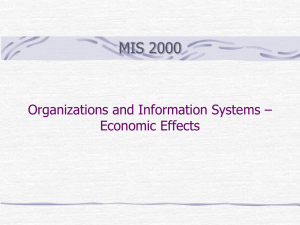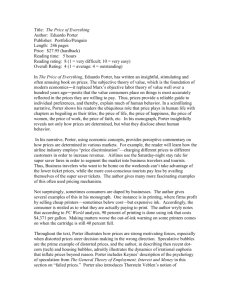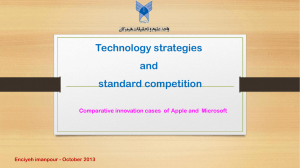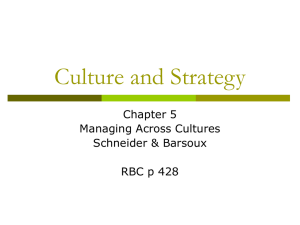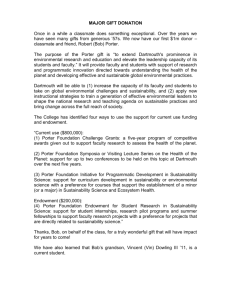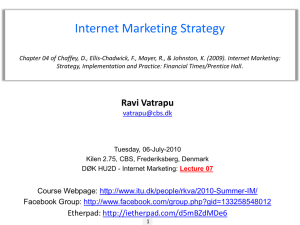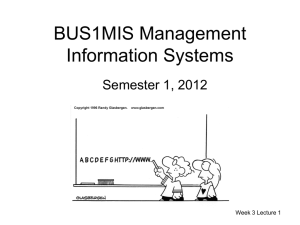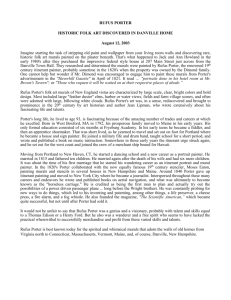Mary G. Porter Traditional School
advertisement
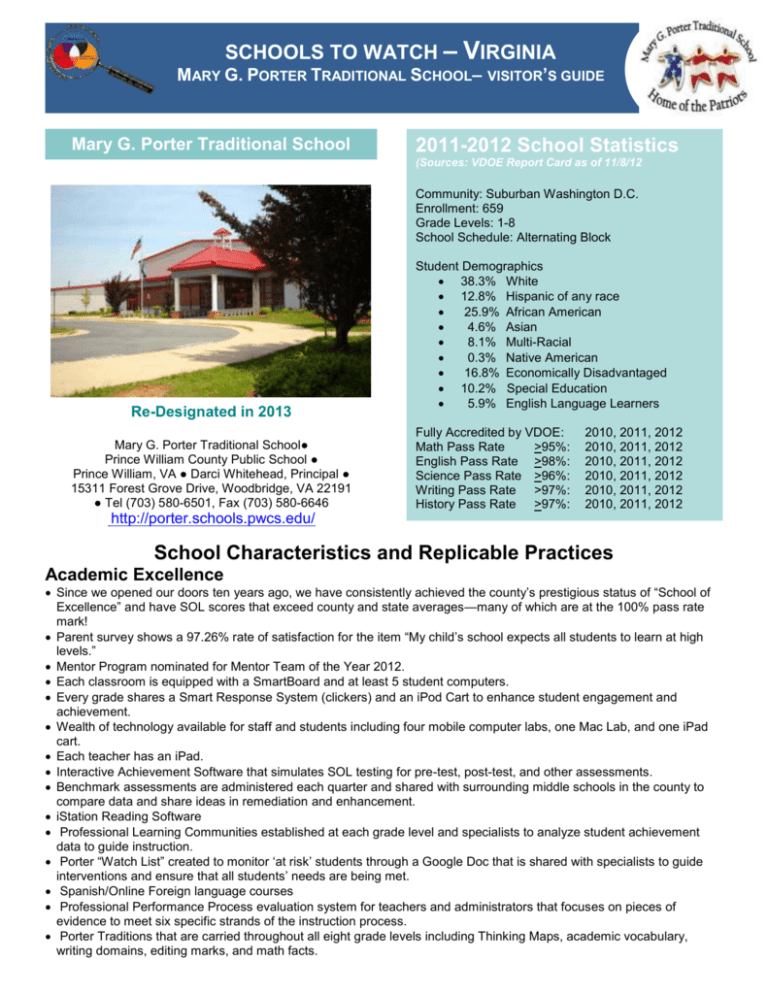
SCHOOLS TO WATCH – VIRGINIA MARY G. PORTER TRADITIONAL SCHOOL– Mary G. Porter Traditional School VISITOR’S GUIDE 2011-2012 School Statistics (Sources: VDOE Report Card as of 11/8/12 Community: Suburban Washington D.C. Enrollment: 659 Grade Levels: 1-8 School Schedule: Alternating Block Re-Designated in 2013 Mary G. Porter Traditional School● Prince William County Public School ● Prince William, VA ● Darci Whitehead, Principal ● 15311 Forest Grove Drive, Woodbridge, VA 22191 ● Tel (703) 580-6501, Fax (703) 580-6646 Student Demographics 38.3% White 12.8% Hispanic of any race 25.9% African American 4.6% Asian 8.1% Multi-Racial 0.3% Native American 16.8% Economically Disadvantaged 10.2% Special Education 5.9% English Language Learners Fully Accredited by VDOE: Math Pass Rate >95%: English Pass Rate >98%: Science Pass Rate >96%: Writing Pass Rate >97%: History Pass Rate >97%: 2010, 2011, 2012 2010, 2011, 2012 2010, 2011, 2012 2010, 2011, 2012 2010, 2011, 2012 2010, 2011, 2012 http://porter.schools.pwcs.edu/ School Characteristics and Replicable Practices Academic Excellence Since we opened our doors ten years ago, we have consistently achieved the county’s prestigious status of “School of Excellence” and have SOL scores that exceed county and state averages—many of which are at the 100% pass rate mark! Parent survey shows a 97.26% rate of satisfaction for the item “My child’s school expects all students to learn at high levels.” Mentor Program nominated for Mentor Team of the Year 2012. Each classroom is equipped with a SmartBoard and at least 5 student computers. Every grade shares a Smart Response System (clickers) and an iPod Cart to enhance student engagement and achievement. Wealth of technology available for staff and students including four mobile computer labs, one Mac Lab, and one iPad cart. Each teacher has an iPad. Interactive Achievement Software that simulates SOL testing for pre-test, post-test, and other assessments. Benchmark assessments are administered each quarter and shared with surrounding middle schools in the county to compare data and share ideas in remediation and enhancement. iStation Reading Software Professional Learning Communities established at each grade level and specialists to analyze student achievement data to guide instruction. Porter “Watch List” created to monitor ‘at risk’ students through a Google Doc that is shared with specialists to guide interventions and ensure that all students’ needs are being met. Spanish/Online Foreign language courses Professional Performance Process evaluation system for teachers and administrators that focuses on pieces of evidence to meet six specific strands of the instruction process. Porter Traditions that are carried throughout all eight grade levels including Thinking Maps, academic vocabulary, writing domains, editing marks, and math facts. Philosophy of an inclusion approach with special education, gifted, and reading resource teachers to better differentiate instruction to meet the needs of all learners. Teachers provide resources and supplemental activities on their classroom webpages via School Fusion. We offer Spanish 1 and 2 to all seventh and eighth grade students along with virtual classes for other languages. Students have the ability to leave middle school with two out of the three required credits of foreign language for high school. Professional Learning Communities create a weekly “Integration Sheet” that outlines their content for the week and how they are going to integrate the four contents together. This also acts as a supplement for our Encore teachers to incorporate the core content into electives. Developmental Responsiveness Identifying student “sparks” at the beginning of the year to begin a relationship with the students and determine what their interests and motivators are. Gifted inclusion teachers teachs student about brain based learning and the multiple intelligences to identify each child’s “smarts.” Creation of the “Geek Squad,” made up of 7th and 8th grade students who are our technology enthusiasts who help maintain the upkeep of our schools technology. The “Geeks” even presented at the VMSA “Schools to Watch” conference! “Yearbook Interns” (students) are given the opportunity to collaborate to create the school’s yearbook. National Junior Honor Society established a tutoring program for 1 st and 2nd graders. Grade level teams have continued to evolve with integration across the content areas to make connections and improve student achievement. We engage in Career Day that is organized by our school counseling department and exposes students to different professions. Our Career Technical Education program allows students to see a wide array of interests from forensic science, marine biology, computers, photography, and business! Pennies for Patents and Operation Turkey are school community projects that raise funds and goods to help cancer research and food for the less fortunate. Technology Showcase allows students to present new technologies and their use in the classroom to the school community. Continue to improve the Encore choices available to students. “Lifeskills” continually offers students the opportunity to learn about cooking, sewing, and career opportunities. “Woodshop” continues to be a student favorite and has created projects to help enhance the school, including bookshelves and platforms so that our younger students can reach the SmartBoards. We have added “Go Green” and “Get Fit” that support our energy and wellness initiatives around the school. Monthly technology trainings allow teachers to be introduced to new technologies and have a chance to become familiar with them to use in the classroom including blogging, Prezi, ShowMe, and iMotion. Jawbone UP! Bands have been purchased to excite and motivate staff and students to increase physical activity and healthy eating. Wellness initiatives with the students including taking laps around the school called our “Milers Club” and exercising 5 minutes before lunch including jump roping, skip-it, and hula-hooping to increase heart rate and metabolism. Social Equity Families and Teachers Chili Night and Lunch Bunches are held to build positive relationships between staff, family and community. A flag is hung in the front hallway for each of the countries that are represented by our school community, we currently have over 70 flags represented! Live 3-D program to promote respect to “diversity, differences, and disabilities.” Multicultural Fair is hosted each year by our Spanish Club to teach students about the cultures in Spanish speaking countries. PTA supports our school needs including technology fundraising, staff recognition, and guidance with community issues. Advisory Council made up of representatives from the school community to help make decisions about our school such as guidance with PWCS Strategic Plan, budgeting, school needs, and student issues. Open Gym is provided for middle school students to have a safe and supervised area to socialize with each other while playing games, sports, and other activities. Integration across the content areas to immerse the students in the content and to make connections. Offer an array of clubs including: Chess, Math 24, debate, Passing on Talents, photography, Cooking Club, Chorus Intramural sports offered include: Baseball, Basketball, Volleyball, Archery, Golf, Cheer/Step, Flag Football Staff is currently participating in ELL training in order to understand and provide services to our second language learners. Inclusion classes with gifted, ELL, and Special Ed to meet the needs and abilities of our diverse student population. Provide a forum for parents of our English Language Learners to learn about the education process called Parents as Education Partners (PEP). .A/B Honor Roll, Perfect Attendance, 600 Club (students who get perfect scores on all SOLs) .Volunteer Hours completed by parents and students. Organizational Support Professional Learning Communities work collaboratively to plan, analyze data, and integrate across the content areas. Grade level chairs and department chairs are responsible for communication of important information to the staff and administration. Weekly implementation of the Special Education Professional Learning Community to analyze the “watch list,” which is used to monitor progress of ‘at risk’ students. Weekly informational meetings with administration and school counselor. Staff participation in “This We Believe” program by AMLE to determine the effectiveness with implementing the best practices for the middle learner. Two self contained ‘non-categorical’ special education classrooms. Alternating block scheduling. Spanish 1 & 2 offered to 7th and 8th grade students. Virtual Virginia classes offered to students who are interested in learning other languages including, Arabic, Latin, and French. Weekly staff newsletters to communicate important information and opportunities. “Collaborative Mentoring Program” for first through third year teachers. Monthly technology meetings for staff to enhance their understanding and support with new technologies to engage students. Porter “Traditions” are carried throughout grades one through eight including uniforms, volunteer hours, editing marks, integration, and Thinking Maps. Professional Performance Process of evaluation where teachers and evaluators review pieces of evidence and data to support learning amongst professionals. Support “work sessions” is held monthly to help teachers understand and collect pieces of evidence to support the PPP evaluation process. Teacher representatives in VISTA (Virginia Initiatives for Science Teaching and Achievement). Teacher participation in the Teaching American History Grant that focuses on content learning and strategies to enhance historical thinking skills. Teacher representatives attended the Florida Educational Technology Conference and presented on integration technology and project based learning.

![[5] James William Porter The third member of the Kentucky trio was](http://s3.studylib.net/store/data/007720435_2-b7ae8b469a9e5e8e28988eb9f13b60e3-300x300.png)
